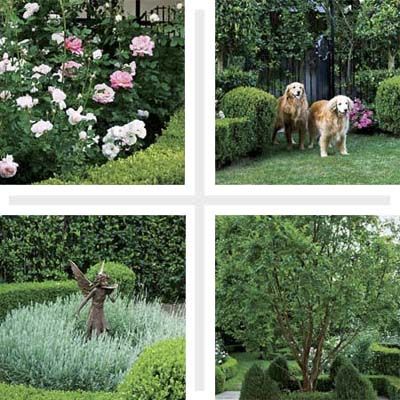
Sheared shrubs offer a cost-effective and visually striking alternative to traditional hardscaping elements. By carefully pruning and shaping shrubs, you can create living walls, columns, and other architectural features that rival their brick or stone counterparts. These green structures not only define areas of your property but also establish sight lines, direct traffic, and highlight focal points in the landscape.
Add Living Architecture to Your Yard Using Shrubs
The garden featured above, located behind a historic English-style Arts and Crafts home in Pasadena, California, exemplifies the use of formal hedging and clipped shrubs to complement the strong lines of the architecture. While this garden may seem grand, you can utilize its principles for yards and gardens of any size. Incorporating sheared shrubs can add structure, depth, and visual interest to your outdoor space.
1. Fill Out Problem Areas in the Yard
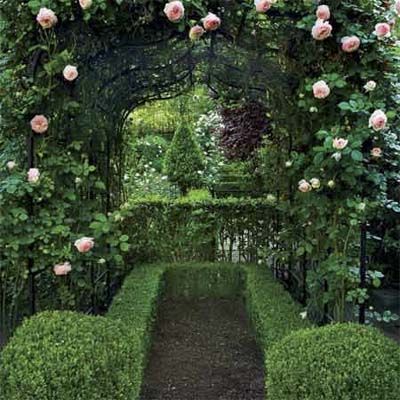
Sheared shrubs solve common landscaping challenges, particularly in areas where other plants might struggle. Under the heavy shade of structures like rose arbors, maintaining a tidy year-round planting of perennials can be difficult. A small pea-gravel pad edged with clipped boxwood offers an elegant solution, providing a clean and structured look without detracting from the beauty of climbing roses or other focal points.
When the roses cease blooming in late summer, the area transforms into a serene green oasis with a more formal ambiance. Consider using ball or square-shaped hedges to mark the entrance to a path or frame a sight line, adding visual interest and structure to your garden design.
TOH Tip: Choose hedging plants that reliably produce leaf buds on old wood, which helps with new growth even when older sections are cut back. Ideal options include Buxus sempervirens (boxwood), English holly, common myrtle, English laurel, copper beech, and Irish yew. These plants tend to bud from bottom to top, providing full leaf coverage throughout the hedge.
2. Use Low Borders to Direct Traffic

Low, sheared borders are effective and attractive guides for foot traffic in your garden. Boxwood creates a clear delineation between the lawn and flower beds in the main garden area, eliminating the need for decorative brick or metal edging. The repetition of various shapes, such as boxwood balls and rectangles at consistent intervals, adds dynamism to the plantings.
Consider placing sheared shrubs on either side of an arbor or your front door to create a formal accent. Treelike cones of clipped wax-leaved privet can flank entrances like elegant columns, adding vertical interest and a sense of grandeur to your garden design. This method provides clear pathways and highlights key entrances and exits.
3. Create Layers of Enclosure
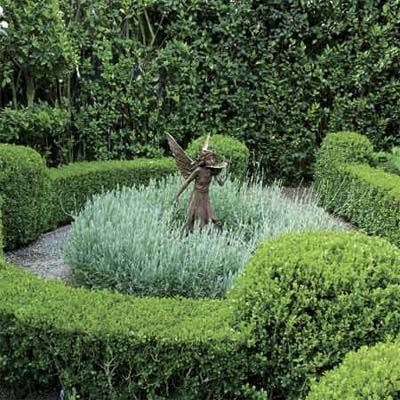
Sheared shrubs excel at creating layers of enclosure, allowing you to define distinct spaces within your garden. In the small side garden pictured, a low boxwood hedge forms a semicircle to highlight a statue surrounded by fragrant lavender. This technique can be applied to showcase various focal points, such as birdbaths or garden art.
In the background, taller clipped plantings provide privacy by screening the security fence behind them. This layered approach adds depth to your garden and creates a sense of intimacy and seclusion in outdoor spaces. Use different hedge heights to establish tiered sections for more dramatic and visually appealing effects.
TOH Tip: Timing rejuvenation pruning correctly is critical to minimize stress on plants. Spring is the optimal time to cut back formal hedges in cold areas, allowing plants to recover and produce new growth throughout the growing season. Most plants can tolerate surface shearing as needed, with frequency depending on the plant type and growing conditions.
4. Mix Plants for More Interest
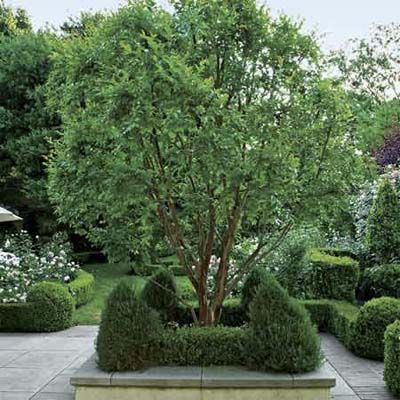
Combining different types of sheared plants can create more varied and interesting edging and focal points. On the patio shown, rosemary cones mark the corners of a small rectangle of boxwood, which sits atop a masonry square. This three-part arrangement is an attractive base for a sculptural crepe myrtle tree, almost like a living planter.
For colder climates, consider substituting tender rosemary plants with dwarf Alberta spruce to achieve a similar effect. Mixing plants with different textures, colors, and growth habits can add depth and visual interest to your sheared shrub designs. Incorporating seasonal plants can also provide year-round appeal, guaranteeing no dull moments in your garden.
5. Conceal the Shortcomings of Leggy Plants
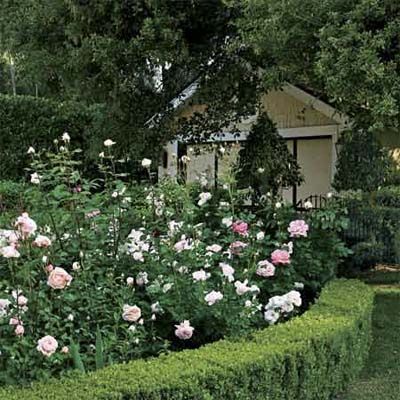
Sheared shrubs can be used strategically to hide the less attractive aspects of other plants in your garden. In this example, a low hedge of boxwood creates a skirt that conceals the bare bases of rosebushes, a common issue with many rose varieties. This technique not only improves the overall appearance of your garden but also provides a strong framework for loose and romantic-looking beds.
With this structured foundation, you can fill the beds with roses and perennials, creating a lush and diverse garden space. The formal lines of the sheared shrubs contrast beautifully with the more natural growth of the flowering plants, resulting in a balanced and visually appealing landscape. This method also allows better airflow and prevents disease among densely planted flowers.
TOH Tip: When shaping hedges, make sure the bottom is slightly wider than the top. This technique, known as tapering, allows more sunlight to reach the lower leaves, preventing unsightly holes and bare branches at the base of the hedge. For a 10-foot-tall hedge, the sides should slope as much as 4 to 6 inches from base to top. To achieve a consistent shape, consider setting four posts and running level string lines along the top and bottom as guides.
Our Conclusion
Sheared shrubs offer a versatile and elegant solution for enhancing your garden’s structure and beauty. You can transform your outdoor space into a well-defined, visually striking landscape by incorporating these five design ideas. Whether you’re looking to solve problem areas, direct traffic, or create layers of interest, sheared shrubs provide endless possibilities for creative garden design.
